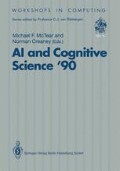Abstract
This paper presents an empirical study and analysis of natural dialogues between experts, novices and partial experts. From this analysis a theory of explanation dialogues is developed known as Extended Schema based Theory (EST). In EST questions are interpreted by combining information from different, semantically related question types which together best capture the essence and meaning of the question. This theory is then applied to the design of an architecture and computational model of interpreting questions and generating explanations. The expert system, named EXPLAIN, understands the nature of the question and is able to take account of the previous dialogue. Also, the system can tailor its responses to an individual user’s characteristics, including level of expertise and depth of knowledge in the domain.
Access this chapter
Tax calculation will be finalised at checkout
Purchases are for personal use only
Preview
Unable to display preview. Download preview PDF.
References
Shortliffe, E. H., Computer based medical consultation: MYCIN, New York: Elsevier, 1976.
McKeown, K., Text Generation: Using Discourse Strategies and Focus Constraints to generate natural language text, Cambridge University Press, 1985.
Swartout, W., XPLAIN: a System for Creating and Explaining Expert Consulting Programs, Artificial Intelligence 21 p 285 - 325, 1983.
Sarantinos E. and Johnson, P. Generating explanations: There is more to it than meets the eye, Proceedings of the International Conference on Information Technology, Tokyo, Japan, October 1 - 5, 1990.
Sarantinos, E. and Johnson, P., Explanation Dialogues: A theory of how experts provide explanations to novices and partial experts, Artificial Intelligence,To Appear.
Gilbert, N., Question and Answer Types. D. S. Moralee (ed), Research and Development in Expert Systems IV, Cambridge: Cambridge University Press, p 162-172, 1987.
Hughes, S., Question Classification in Rule-based Systems. Research and development in expert systems II, Cambridge University Press, 1986, 123131.
Lehnert, W., The process of Question Answering: A computer Simulation of Cognition" Chapter 3. Lawrence Erlbaum Associates, Hillsdale, N.J. 1978.
Nicolosi, E., Leaning, M. S, Boroujerdi, M. A., The Development of an Explanatory System Using Knowledge-Based Models, In Proceedings of the 4th Explanations Workshop, Manchester University, 14 - 16 Sept 1988.
Pilkinghton, R., Tattersall, C, Hartley, R., Instructional Dialogue Management. CEC ESPRIT p-280 EUROHELP, 1988.
Wexelblat, R., The Confidence of Their Help, AAAI’88 Workshop on Explanation, p 80 - 82, 1988.
Maybury, M., M.Phil Thesis: A Report Generator, Engineering Department Library, Cambridge University, 1987.
Valley, K., Explanation Generation in an Expert System Shell. Department of Artificial Intelligence, University of Edinburgh, 80 South Bridge, Edinburgh, EH1 1HN, 1988.
Cawsey, A., Explaining the behaviour of simple electronic circuits, International Conference on Intelligent Tutoring Systems, Montreal, June 1988.
Williams, W., Composition and Rhetoric, DC. Heath and Co, Boston, 1893.
Shipherd, H. R., The fine art of writing, The MacMillan Co, New York, N.Y., 1926.
Grimes, J E., The thread of discourse. Mouton, The Hague, Paris, 1975.
Sacerdoti, E., A structure for plans and behaviour, Elsevier North-Holland, Inc., Amsterdam, 1977.
Moore, J. and Swartout, W., A reactive approach to explanation, Proceedings of the Fourth International Workshop on Natural Language generation, Los Angeles, 1988.
Mann, W. and Thompson, S., Rhetorical Structure Theory: Toward a functional theory of text organization, TEXT b (3) 1988 243 - 281. 3.
Ballim, A., and Wilks, Y., Stereotypical Belief and Dynamic Agent Modelling, Proceedings of the Second International Workshop on User Modelling, Hawaii, USA, 1990.
Cawsey, A., Explanatory Dialogues, Interacting with Computers, 1: 69 - 72, 1989.
Sarantinos E. and Johnson, P. Explanation Dialogues: A computational model of interpreting questions and generating tailored explanations, Proceedings of the 5th UK Workshop on Explanations, Manchester University, UK, April 2527, 1990.
Wilkins, D., Domain independent planning: Representation and plan generation, Artificial Intelligence, 22: 269 - 301, 1984.
Doyle, R., Atkinson, D., Doshi, R., Generating perception requests and expectations to verify the execution of plans, Proceedings of the Fifth National Conference on Artificial Intelligence, p 81-88, Philadelphia, Pennsylvania, 1986.
Broverman, C., and Croft, W., Reasoning about exceptions during plan execution monitoring, Proceedings of the Sixth National Conference on Artificial Intelligence, Seattle, Washinghton, 1987.
Sidner, C., Towards a computational theory of definite anaphora comprehension in English discourse, Ph.D dissertation, MIT, Cambridge, Mass., 1979.
Kass, R., Implicit Acquisition of User Models in Cooperative Advisory Systems, Technical Report MS-CIS-87-05, Department of Computer Science, University of Pennsylvania, 1987.
Sarantinos, E. and Johnson, P. Tailoring Explanations to the User’s Level of Expertise and Domain knowledge, Proceedings of the 2nd International Conference on Tools For Artificial Intelligence 90 (TAI 90), Washington D.C., USA, 1990.
Sarantinos, E. and Johnson, P. Consultation Dialogues, Proceedings of the AAAI-90 Workshop on Complex Systems, Ethnomethodology and Interaction Analysis, Boston, USA, 1990.
Sarantinos, E. and Johnson, P. Interpreting questions and generating explanations during consultation dialogues, Proceedings of the Pacific Rim International Conference on Artificial Intelligence ‘90 (PRICAI 90), Nagoya, Japan, 1990.
Editor information
Editors and Affiliations
Rights and permissions
Copyright information
© 1991 Springer-Verlag Berlin Heidelberg
About this paper
Cite this paper
Sarantinos, E., Johnson, P. (1991). Allowing Multiple Question Types to Influence the Resulting Explanation Structure. In: McTear, M.F., Creaney, N. (eds) AI and Cognitive Science ’90. Workshops in Computing. Springer, London. https://doi.org/10.1007/978-1-4471-3542-5_20
Download citation
DOI: https://doi.org/10.1007/978-1-4471-3542-5_20
Publisher Name: Springer, London
Print ISBN: 978-3-540-19653-2
Online ISBN: 978-1-4471-3542-5
eBook Packages: Springer Book Archive

